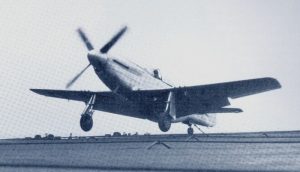By Gaëtan Marie of Bravo Bravo Aviation.
With a surface of 69 millions square miles, the Pacific Ocean covers nearly a third of the Earth’s surface. During World War II, military operations in the Pacific were confronted with the problem of range. This was particularly true of aerial operations. Mainland Japan was bombed on 18 April 1942 by Doolittle and his raiders, but that was a one-time effort of mostly psychological value. All of the 16 aircraft involved were lost, and 11 of the 80 raiders were either killed or captured. After that, no bombing raids were flown against the Japanese Home Islands until the second half of 1944 when B-29 long-range bombers were used from bases in China and later the Marianas islands. These raids were unescorted as no fighter had the range to escort the bombers all the way to Japan and back.
The lack of escorts for the B-29s became a growing concern. One of the solution that was considered was to have fighter launched from aircraft carriers located closer to Japan join the bombing raid. Even so, no naval fighter had enough range. The only fighter which seemed suitable for this was the North American P-51 Mustang.
The P-51 was conceived, designed and built by North American Aviation (NAA), under the direction of lead engineer Edgar Schmued, in response to a specification issued directly to NAA by the British Purchasing Commission; the prototype NA-73X airframe was rolled out on 9 September 1940, albeit without an engine, 102 days after the contract was signed and it was first flown on 26 October.[1] The Mustang was originally designed to use a low-altitude rated Allison V-1710 engine, and was first flown operationally by the Royal Air Force (RAF) as a tactical-reconnaissance aircraft and fighter-bomber. The definitive version, the P-51D, was powered by the Packard V-1650-7, a licence-built version of the Rolls-Royce Merlin 60 series two-stage two-speed supercharged engine, and armed with six .50 caliber (12.7 mm) M2 Browning machine guns. This article covers the various variants of the P-51.
On 15 November 1944, naval aviator (and later test pilot) Lieutenant Bob Elder, in a P-51D-5-NA 44-14017, started flight tests from the deck of the carrier Shangri-La. This Mustang had been fitted with an arrestor hook, which was attached to a reinforced bulkhead behind the tail wheel opening; the hook was housed in a streamlined position under the rudder fairing and could be released from the cockpit. Thus modified, 44-14017 was redesignated ETF-51D and sent to Mustin Field, near Philadelphia, for initial testing in September 1944. The pilot in charge of testing the ETF-51D was Navy Lieutenant Robert M. Elder. He was an experienced naval test pilot who had already conducted carrier-suitability trials with several types of aircraft.The tests showed that the Mustang could be flown off the carrier deck without the aid of a catapult, using a flap setting of 20° down and 5° of up elevator. Landings were found to be easy, and, by allowing the tail wheel to contact the deck before the main gear, the aircraft could be stopped in a minimum distance.
Navy Lieutenant Robert Elder made the first P-51 carrier landing on November 15, 1943. The carrier suitability trials ended after only 25 landings and launches were made. The airfields on the islands of Okinawa and Iwo Jima were taken over by US forces in early 1945, providing fighter units with forward bases to escort the bombers to mainland Japan. Thus a navalized P-51 was no longer required and the program was terminated.
Sources:
Gaëtan Marie of Bravo Bravo Aviation.




























